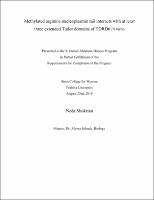Please use this identifier to cite or link to this item:
https://hdl.handle.net/20.500.12202/4765Full metadata record
| DC Field | Value | Language |
|---|---|---|
| dc.contributor.advisor | Schuck, Alyssa | - |
| dc.contributor.author | Shokrian, Neda | - |
| dc.date.accessioned | 2019-10-10T14:31:36Z | - |
| dc.date.available | 2019-10-10T14:31:36Z | - |
| dc.date.issued | 2019-08-23 | - |
| dc.identifier.citation | Shokrian, Neda. (August 23, 2019). Methylated arginine nucleoplasmin tail interacts with at least three extended Tudor domains of TDRD6 in vitro. Presented to the S. Daniel Abraham Honors Program in Partial Fulfillment of the Requirements for Completion of the Program Stern College for Women Yeshiva University. | en_US |
| dc.identifier.uri | https://hdl.handle.net/20.500.12202/4765 | - |
| dc.description | Honors student thesis, Open Access (OA) per signed student consent form. | en_US |
| dc.description.abstract | The Central Dogma of biology states that in a cell, DNA must undergo transcription in order to produce RNA, which is then translated into protein. During early embryogenesis in Xenopus laevis, however, newly fertilized egg cells rapidly replicate their tightly wound DNA, using proteins not produced by standard method, and the genome is transcriptionally silent. Xenopus egg cells contain maternal messenger ribonucleoprotein (mRNP) particles that function to store maternal mRNA in a translationally repressed state. After fertilization, the mRNP particles are somehow remodeled to trigger translation of their stored mRNA transcripts until zygotic genome activation (ZGA). Amongst a handful of proteins contained in the mRNP particles is Tudor domain containing 6 (TDRD6). Various Tudor domain proteins have been shown to interact with binding partners containing arginine-methylated motifs. Nucleoplasmin (Npm2) is the predominant storage chaperone for histones H2A and H2B in Xenopus oocytes. The C-terminus tail has a methylated arginine residue whose function is unknown. We hypothesized that the arginine-methylated Npm2 C-terminal tail modulates interaction with TDRD6 to de-repress the translational block of maternal mRNPs during early embryogenesis. Purification of several extended Tudor domains (eTUDs) of TDRD6, followed by an in vitro interaction assay with Npm2 constructs, showed that Npm2- C19 with arginine methylation pulled down eTUDs 2, 5, and 6, while Npm2-C19 without arginine methylation did not pull down any eTUDs. While further experiments must be conducted, a connection is now established between the binding of the eTUDs and the methylated arginine residue of the Npm2 tail. | en_US |
| dc.description.sponsorship | S. Daniel Abraham Honors Program | en_US |
| dc.language.iso | en_US | en_US |
| dc.publisher | NY: Stern College for Women. Yeshiva University. | en_US |
| dc.rights | Attribution-NonCommercial-NoDerivs 3.0 United States | * |
| dc.rights.uri | http://creativecommons.org/licenses/by-nc-nd/3.0/us/ | * |
| dc.subject | Honors student thesis | en_US |
| dc.subject | Methylated arginine nucleoplasmin tail | en_US |
| dc.subject | extended Tudor domains of TDRD6 | en_US |
| dc.title | Methylated arginine nucleoplasmin tail interacts with at least three extended Tudor domains of TDRD6 in vitro. | en_US |
| dc.type | Thesis | en_US |
| Appears in Collections: | S. Daniel Abraham Honors Student Theses | |
Files in This Item:
| File | Description | Size | Format | |
|---|---|---|---|---|
| Neda Shokrian OA Thesis Aug2019.pdf | PDF OA per signed student consent form | 875.25 kB | Adobe PDF |  View/Open |
This item is licensed under a Creative Commons License

